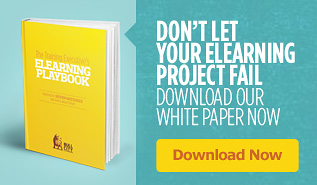In the quest to find the right eLearning vendor, it’s all too easy for a project sponsor be seduced by a proposal that sounds too good to be true. That vendor who talks a good game may turn out to be a perfect match. But it’s not uncommon to choose a vendor who turned in an amazing proposal, only to feel let down once the project work begins.
 That’s because writing an impressive proposal is one skill and developing a creative, effective learning solution is another.
That’s because writing an impressive proposal is one skill and developing a creative, effective learning solution is another.
Fortunately, there’s a solution for avoiding this pitfall. Follow these four strategies to help you identify an Awesome eLearning Producer, not just an Awesome Proposal Writer.
1. Evaluate, keeping your top criteria in mind.
It’s usually a good idea to pull together a committee to participate in the evaluation and selection of vendors. And this committee, before they evaluate anything, should know what the most important criteria are for the project -- which vendor capabilities and qualities are considered high value and which are less essential.
For example, if having the course ready for an annual meeting is a critical factor, then you may be able to go slightly over budget and still be successful. Therefore, you could allow for variability on the “cost” proposed by various vendors.
Every project won’t have the same criteria. Knowing what’s most important will help a committee determine how to evaluate proposals and select the right vendor. In practice, these evaluation criteria will usually take the form of qualitative variables related to your values. Your review committee can then rate the vendor on each variable on a scale of, say, one to five.
2. Ask for vendor presentations.
A rigorous evaluation process includes presentations. Presentations allow for a higher level of scrutiny, so don’t pass up the opportunity to invite potential vendors for face time. Whoever wrote the proposals isn’t likely the one who will be involved in the creation of the learning solution. In fact, very often, a high-level Ph.D. will create the proposal and then a lower-level resource is put on the team. That’s why you can’t make a vendor-selection decision based solely on the proposal.
Furthermore, if you have questions, or if you need more of an explanation from the vendors to fully understand their ideas, a presentation is going to fill those gaps.
Allow ample time during presentations for Q&A. Take the opportunity to delve further into some of the questions that appeared on the RFP. Examples: “Will the individuals profiled in your proposal be the ones on my project team? How involved will they be? How much time every week would they spend on the project, on average?”
3. Scrutinize the vendor’s past work.
That means not only evaluating the quality of work on your own but asking the vendor about the project, its origination, what the process was, how long it took to create, whether it came in on or over budget, how much time was required by the SME, whether there were any process hiccups – and then, importantly, requesting to speak with the client of that work to question them and validate all of those questions.
4. Contact references.
Without talking to a candid former client, a project sponsor may be unable to see behind the polish and veneer that every vendor presents. Which vendor is prone to falling behind on deliverable timelines? Which one produces courses that look good but fail to change learners’ behavior? Which one is difficult to work with? Only a well-executed reference check provides those answers.
(Avoid making these three common mistakes when it comes to checking references.)
There’s no “magic bullet” eLearning solution to miraculously meet every learning need. Finding that perfect fit is what vendor selection is all about.
You’ll find more real-world tips on vendor selection in our latest eBook, “The Ultimate Roadmap for Selecting the Right eLearning Vendor."


